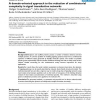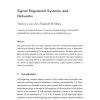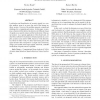815 search results - page 35 / 163 » Complexity classes for membrane systems |
BMCBI
2006
13 years 8 months ago
2006
Background:Receptors and scaffold proteins possess a number of distinct domains and bind multiple partners. A common problem in modeling signaling systems arises from a combinator...
COMPLEXITY
2010
13 years 3 months ago
2010
The paper presents the use of signal regulatory networks, a biologically-inspired model based on gene regulatory networks. Signal regulatory networks are a way of understanding a ...
ICASSP
2011
IEEE
13 years 14 days ago
2011
IEEE
Localization and classification of acoustic signals in a complex auditory scene is an every day task of the human auditory system. However, this problem presents a significant c...
ICDT
2009
ACM
14 years 9 months ago
2009
ACM
The ability to flexibly compose confidence computation with the operations of relational algebra is an important feature of probabilistic database query languages. Computing confi...
CORR
2006
Springer
13 years 8 months ago
2006
Springer
In multiple-input multiple-output (MIMO) fading channels maximum likelihood (ML) detection is desirable to achieve high performance, but its complexity grows exponentially with th...



